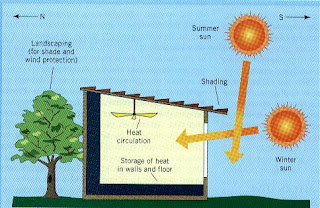Passive Solar Design - Methods and Benefits in Home Design
Now you can go green,
save energy and money while enjoying the sun. Your home can be designed to take
advantage of the power of the sun. Passive solar design is the art and science of using the sun's
energy and the geographical climate to suit your home. Specifically designed to
keep you warm during winter, and keep you cool during summer.
Passive
solar design has many benefits. It reduces the cost
of utilities, there is little need for maintenance and it is more reasonably
priced than its counterparts. Not only does this save your money but it also
saves our natural resources, minimizing the use of fossil fuels which has
negative impact on our environment.
There are many ways to
use passive solar design techniques
but it’s relatively easier to do this when designing for a new home.
Nevertheless, existing buildings can be modified to gather and store solar
heat. In building the perfect passive home, here are the things to consider.
The first principle of
passive solar house design is orientation. This pertains to the position of the
house in relation to the sun, to ensure that it would supply maximum
performance and take advantage of energy savings.
Next to take in account
is the glazing. Glazing or south facing glass absorbs the sunlight that
enters the home. These are basically windows that act as collectors of heat and
distribute it evenly through the house. Southern facing windows are very
important because the southern side will most likely absorb natural light
throughout the day. There are many kinds of overhangs; it can be louvered,
solid, vegetation-supporting or combinations of the three. It can also be
operable, fixed or removable.
Then there is the thermal mass. Thermal mass are materials
that retain the heat produced by sunlight. It is the material underneath or
behind whereas the absorber is an exposed surface, although they often form the
same wall or floor.
 |
Disclaimer: Photos are not mine. Therefore borrowed. Thank you!
|
The most basic of all
solar passive techniques is suntempering. It is basically increasing the number
of windows on the south side. It is very low cost as it is done without adding
extra thermal mass apart from the framing.
On the other hand, Direct gain pertains to the heat that enters the house through windows, warming the inside space. After the sun goes down, the heat stored by the thermal mass will continue to emit into the space.




